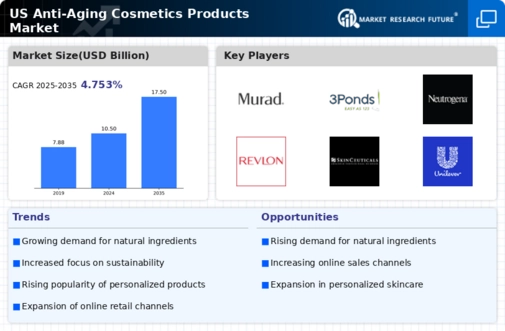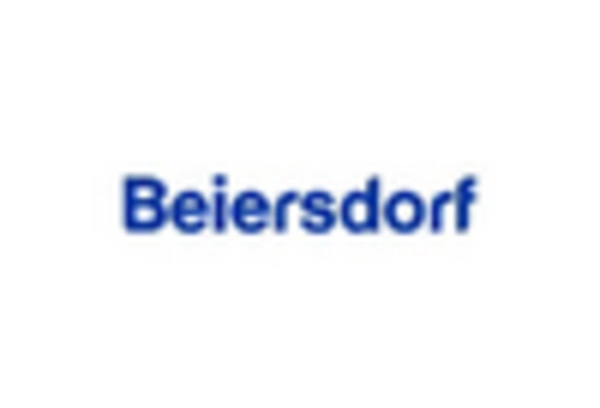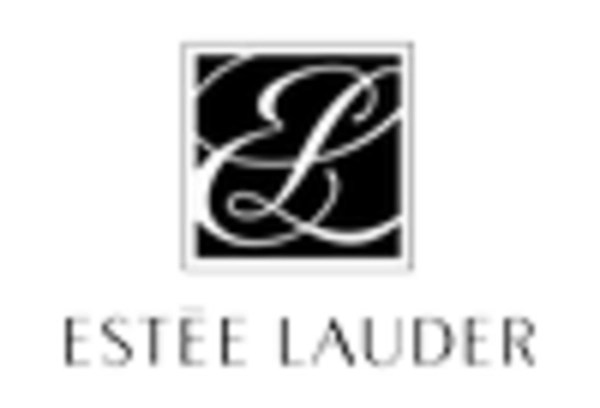Increasing Aging Population
The demographic shift towards an older population in the US is a primary driver for the anti aging-cosmetics-products market. As life expectancy rises, a larger segment of the population is seeking products that address age-related concerns. By 2030, it is projected that 20% of the US population will be over 65 years old, leading to heightened demand for anti aging solutions. This trend indicates a growing market for products that promise to reduce the visible signs of aging, such as wrinkles and fine lines. Consequently, companies are focusing on developing innovative formulations that cater to this demographic, thereby expanding their market share in the anti aging-cosmetics-products market.
Rising Awareness of Skin Health
There is a growing awareness among consumers regarding the importance of skin health, which is propelling the anti aging-cosmetics-products market. Educational campaigns and social media influence have heightened consumer knowledge about the effects of environmental factors on skin aging. As a result, individuals are increasingly investing in skincare routines that include anti aging products. Reports indicate that the skincare segment, particularly anti aging products, is expected to grow by approximately 7% annually through 2027. This heightened focus on skin health encourages consumers to prioritize preventive measures, thus driving demand for products that promise to maintain youthful skin.
Technological Advancements in Formulations
Innovations in cosmetic science are significantly influencing the anti aging-cosmetics-products market. Advances in biotechnology and dermatological research have led to the development of more effective ingredients, such as peptides and antioxidants, which are known to enhance skin rejuvenation. The introduction of novel delivery systems, such as nanotechnology, allows for better absorption of active ingredients, thereby improving product efficacy. As consumers become more informed about these advancements, they are likely to seek out products that utilize cutting-edge technology. This trend not only boosts consumer confidence but also drives sales in the anti aging-cosmetics-products market, as brands that leverage these innovations can differentiate themselves in a competitive landscape.
Growing Demand for Natural and Organic Ingredients
The shift towards natural and organic ingredients is a notable driver in the anti aging-cosmetics-products market. Consumers are becoming more conscious of the ingredients in their skincare products, leading to a preference for formulations that are free from harmful chemicals. This trend is reflected in the increasing sales of products labeled as 'clean' or 'organic,' which are perceived as safer and more effective. Market data suggests that the demand for natural ingredients in cosmetics is expected to grow by 10% annually. As a result, brands are reformulating their products to include botanical extracts and other natural components, thereby aligning with consumer preferences and enhancing their appeal in the anti aging-cosmetics-products market.
Influence of Social Media and Celebrity Endorsements
The role of social media and celebrity endorsements in shaping consumer preferences cannot be understated in the anti aging-cosmetics-products market. Platforms like Instagram and TikTok have become vital channels for brands to showcase their products and engage with potential customers. Influencers and celebrities often share their skincare routines, which frequently include anti aging products, thereby creating a perception of necessity among their followers. This trend has led to a surge in product visibility and consumer interest, as individuals aspire to replicate the looks of their favorite personalities. Consequently, brands that effectively utilize social media marketing strategies are likely to see increased sales in the anti aging-cosmetics-products market.

















Leave a Comment